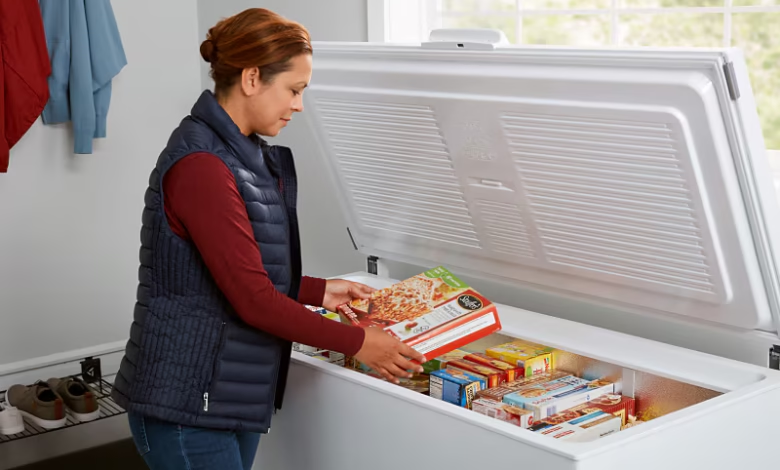Freezer Freezers: Your Ultimate Guide to Deep-Freeze Bliss

I’m excited to walk you through everything you need to know about freezer freezers, your dedicated deep freeze companions that go far beyond your regular fridge freezer. Whether you’re stocking up on seasonal goods, prepping meals, or battling the freezer-burn beast, you’ve landed in the right spot. Let’s dive into the frozen world together.
What’s in a Name: Understanding “Freezer Freezers”
The Deep Freezer Identity
When we say freezer freezers, we’re talking about standalone units—aka deep freezers—that freeze things solid at around 0 °F (−18 °C). These bad boys come in two main styles: chest and upright. Both are deep freezers, taking the melting temperature notion to new depths—and into bulk storage bliss.
Why “Freezer Freezers” Makes Sense
The term may sound redundant, but there’s logic here. One “freezer” emphasizes the function—freezing things hard—while the second refers to the physical appliance dedicated entirely to cold storage. It’s like saying “freeze freezer,” which just doubles down on the point.
Chest vs. Upright: Clash of the Deep Freezers
Chest Freezers: Volume & Power Efficiency
Chest freezers are horizontal workhorses—big capacity, perfect for bulky purchases or entire harvests. They hold cold air beautifully when opened and tend to stay colder longer during a power outage.
A Redditor nails it:
“Chest freezers have a compressor. No fans, no defrost controller or heater. There is a lot less to go wrong. New ones use very little electricity.”
Uprights: Sleek, Organized, Access-Friendly
Upright units look like tall fridges with doors you swing open. They save floor space, feature shelves and drawers for neat organization, and often include automatic defrost features that save you from chipping away ice.
How Freezers Keep It Cold: The Science Behind the Freeze
Your freezer is powered by a simple yet brilliant system. Here’s how it keeps the chill alive:
- The compressor squeezes refrigerant, heating it.
- Condenser coils cool the refrigerant, turning it liquid.
- The capillary tube lowers pressure, prepping refrigerant for the freezer interior.
- The evaporator absorbs heat, freezing your food.
- Cycle starts again—freeze after freeze.
That’s the vapor-compression principle in action. It’s the same tech behind your fridge, but dedicated just to freezing.
Choosing the Right “Freezer Freezer” for You
Size Matters (and More)
Every household has different needs:
| Household Size | Recommended Capacity |
| 1–2 people | Compact: ~5 cu ft |
| Family of 4 | Medium: ~12–18 cu ft |
| Large or Bulk Buyers | Large: 18+ cu ft |
Bear in mind, a well-used Freezer runs more efficiently if kept about two-thirds full.
Placement & Use
Planning to store a whole deer, seasonal veggies, or hearty batches of meal preps? Chest freezers are your go-to. Short on space and prefer tidy aisle-style access? Uprights give you reach-in convenience.
Defrost Style
- Manual Defrost: Most energy-efficient, but needs periodic thawing.
- Frost-free/Auto-defrost: Convenient, melts ice automatically—useful if you detest the defrost chore.
Energy Efficiency & Extras
An energy-efficient model saves $ and carbon. Look for ENERGY STAR rating, good insulation, and features like lights, locks, or fast-freeze. For garage placement, “garage-ready” is a must.
Organizing, Maintaining, and Maximizing Your Freezer
Let’s make freezer life smooth, useful, and efficient.
Smart Organization Hacks
- Use clear bins or baskets—saves time during floor dives.
- Label and date packages.
- Group items by type (meats in one, soups in another).
- Keep a running inventory—a post-it list on the Freezer Freezers door or a digital tracker.
Cleaning & Defrosting Tips
From Food & Wine:
- Empty the freezer and discard freezer-burnt or expired items.
- Unplug and let ice melt naturally; use towels and trays to catch water.
- Clean with a mild cleaner, dry thoroughly, and restart the freezer before loading.
Best Temp Setting
Set the temperature at 0 °F (–18 °C) to keep food safe and prevent freezer burn. Going colder doesn’t help much TV-wise and can raise energy use.
Real-World Tips: Expert Voices & Extra Resources
From seasoned users:
Julie Laing, with 15+ years of deep freezer expertise, recommends Magic Chef 7.0 cu ft Chest, Insignia 14 cu ft Garage-Ready Chest for budget buys, and Maytag 15.7 cu ft Frost-Free Upright for low-maintenance reliability.
More reading from trusted sources:
- Consumer Reports—Freezer Buying Guide (in-depth choice, features, pros/cons)
- Whirlpool’s 2025 Freezer Buying Guide (useful comparisons and tips)
- Homes & Gardens—Best Chest Freezers (brand and feature comparisons)
Frequently Asked Questions (FAQs)
What exactly is “freezer freezers”?
It’s a fun way to say standalone deep freezers—those hefty units dedicated solely to freezing, not a fridge combo.
Chest or upright—which should I get?
Go chest if you need maximum storage and efficiency. Upright is better if you want space-saving placement and easy organization.
How cold should I keep it?
Set it to 0 °F (–18 °C)—the sweet spot for long-term food safety.
Do I have to manually defrost?
Not necessarily—pick frost-free if you hate chipping ice. Manual models are more efficient but require occasional thawing.
How do I keep it organized?
Use bins, labels, and inventory lists. First in, first out helps. Clear visibility avoids the dreaded freezer black hole.
What extras are worth it?
Look for energy efficiency, a light, a lock (for kids or garage safety), fast-freeze mode, and sturdy door seals.
Final Chill Thoughts
Selecting your ideal freezer boils down to balancing capacity, convenience, energy use, and defrosting preferences. Whether you go chest for bulk freezing muscle or upright for daily ease, a bit of planning and smart maintenance goes a long way. Stay organized, keep it at the right temp, and let your freezer take care of the cold work—so you can relish the convenience of frozen abundance.